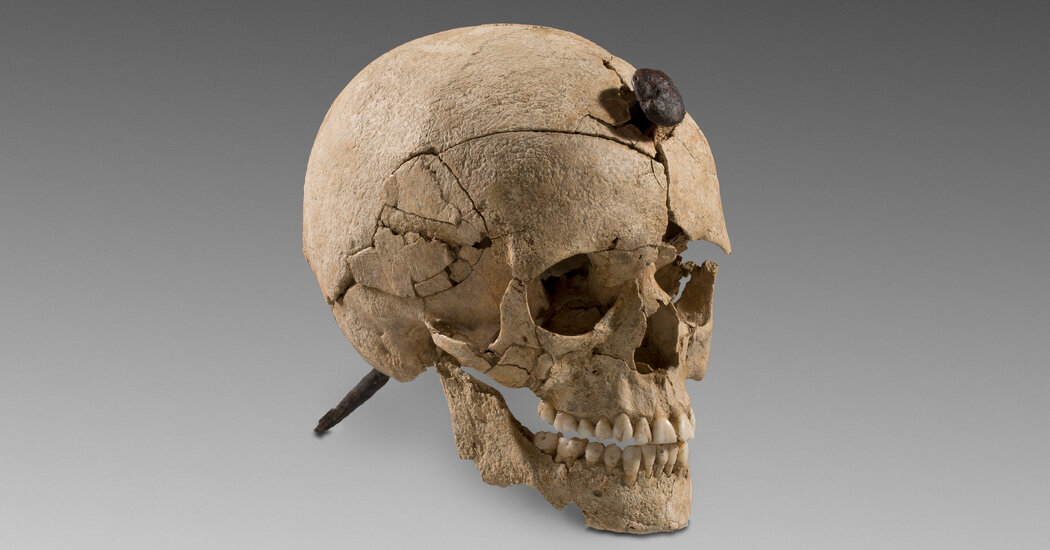Some 2,000 years ago, a macabre ritual was observed in the northeastern Iberian Peninsula, a region of Spain known today as Catalonia. In several settlements, the skulls of the dead were publicly exhibited: on porches, or mounted on walls and stakes. Most unsettling, some had iron nails driven through them.
Dozens of such skulls, dating to the Iron Age, or roughly 800 B.C. to 218 B.C., have been found across the area since 1904. Scholarly theories about them have fallen into two camps: The skulls were either respected ancestral relics or war trophies meant to induce fear in local rivals, depending on the tribe.
But in a recent paper in The Journal of Archaeological Science, Rubén de la Fuente-Seoane, an archaeologist at the Autonomous University of Barcelona, argues that those hypotheses alone are too simplistic; more likely, the meaning of the skulls depended on whom they belonged to and where they were placed. “Our study shows that it may be a mistake to have to choose only one option,” he said.
Dr. de la Fuente-Seoane and his research team examined seven skulls from two Iberian Peninsula settlements, Puig Castellar and Ullastret. Both sites were established around the sixth century B.C., a time when political violence intensified, as shown by the appearance of weapons in burials and evidence of fatal injuries, including beheadings, in human remains. Between 350 B.C. and 200 B.C., the northern Iberian Peninsula village of La Hoya, located on a trade route in the fertile Ebro River valley, was destroyed in what is believed to have been a politically motivated massacre.
Archaeological findings from 2020 indicated that attackers burned the village and left the remains of men, women and children where they fell. Examination of the bodies revealed fatal injuries from bladed metal weapons, with some victims decapitated or dismembered. Valuables were deliberately ignored, leading the researchers to speculate that the attack was carried out by a neighboring faction seeking regional control and total annihilation of the settlement.
Puig Castellar is situated on a hill with a commanding view of the coast. Ullastret is inland and was the capital of the territory known as Indiketes. The two settlements were abandoned by the late third or early second century B.C., probably in response to invading Romans.
Dr. de la Fuente-Seoane reasoned that by analyzing the ratio of different atomic isotopes in the skulls’ tooth enamel, his team would be able to determine whether they belonged to locals or outsiders. Presumably, the skulls of locals would have been venerated, whereas those of outsiders would have been kept as badges of honor.
Isotopes of the element strontium make their way from the local soil and water into the tooth enamel of whoever consumes them, and serve as a geological identifier of where food was grown. Because tooth enamel forms in childhood and does not change, it permanently records where a person was raised.
Similarly, scientists can trace where a person lived by studying oxygen isotopes in their drinking water, which reflect environmental conditions such as temperature, altitude and proximity to the sea. When paired with strontium data, this information helps reconstruct an individual’s geographic history and movements.
Dr. de la Fuente-Seoane and his research team used this technique on four skulls found in prominent locations near the exterior walls and main entrance to Puig Castellar. The results showed that three of the skulls — from an adolescent and two adults younger than 35 — were most likely from other areas, while the fourth, whose age is unknown, was probably from a local.
This led Dr. de la Fuente-Seoane to propose that the deliberate effort to make the remains of the outsiders visible on structures such as fortified walls or gates was meant to be a show of force, warding off both internal and external adversaries.
Based on their analysis of three nailed skulls from the Ullastret site, researchers concluded that locals and foreign enemies were treated differently in death. The three skulls belonged to adults under 40. Two were found to be from residents of the Ullastret community and were showcased in homes. Dr. de la Fuente-Seoane said that those skulls might have been used as tributes by the individuals’ families, a way of honoring their relatives as important community members.
“Some classical texts mention the use of cedar oil in the treatment of preserved heads kept as trophies,” Dr. de la Fuente-Seoane said. In a 2016 study involving organic residue analysis of several skulls from Ullastret, researchers looked for vestiges of such residues but found none.
A third Ullastret skull, deemed to be of foreign origin, was discovered in a ditch outside the settlement’s walls. This suggests that it, too, was a military trophy, but its placement in a less conspicuous location implies a different symbolic use than that of the skulls outside Puig Castellar. Dr. de la Fuente-Seoane wondered if the third skull could be linked to the Gaulish practice of using skulls as religious offerings or spoils of war, after which they were stored in pits.
However, he said, this cannot be proven without knowing the skull’s original context. He also cautioned that more research was needed, such as broader isotope analyses, to reliably support the initial findings.
Jordi Principal, director of the History Museum of Catalonia, said he was surprised to learn that the two hypotheses — reverent remembrance and trophy-taking — are nonexclusive, and that both practices coexisted.
He observed that “the evidence seems to suggest that perhaps not all of the tribes considered this practice in the same way, which would be probably determined by the sociocultural context of each community.” Nevertheless, he said, the exhibition of the skulls consistently served a single purpose: to express and project power.
The post In Ancient Spain, a Nail Through the Skull Could Mean Enmity, or Honor appeared first on New York Times.




